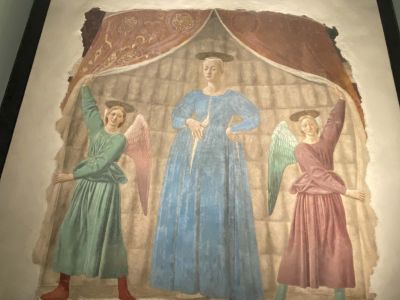A Monterchi, cittadina del sud della Toscana, le donne incinte possono entrare gratuitamente nei musei. In questa città si trova il capolavoro di Piero della Francesca: "Madonna del Parto". L'affresco raffigura la Madonna nelle ultime settimane di gestazione, quasi pronta a partorire. Sotto l’affresco, c'è un cestino delle preghiere di tante mamme che vogliono l'aiuto della Madonna. Vicino a questo affresco si trova un votivo dedicato alla Madonna del Latte. Per molti secoli, le madri pregarono la Madonna perché abbondassero di latte per crescere i loro bambini. Insomma Monterchi è una città da visitare per tante donne, quelle che vogliono essere mamme e quelle che già lo sono.
Did you know there is a museum in Italy where pregnant women are exempt from an admission fee? In the small, southern Tuscan town of Monterchi, pregnant women enter free to see the 15th-century Renaissance masterpiece of Piero della Francesca, “Madonna del Parto” (“Madonna of Childbirth”). Piero della Francesca was a master of perspective and a brilliant mathematician, writing various mathematical treatises.
The mysteries linked to this splendid fresco are fascinating. Who commissioned the fresco likely painted between 1450 and 1475 for a small church outside of the town? Why was the fresco painted on a back wall of that small chapel on a wooded hill? And why was Piero della Francesca, already famous, chosen to fresco in a humble church outside of a tiny village?
The Madonna stands in reflection under precious and elegant brocaded drapery. She is in an advanced state of pregnancy, her eyes lowered, and her thoughtful look seems to predict the future sufferings of the Child in her womb. Her face is solemn and humble as she caresses her bulging stomach.
The angels open the drapery with a decided, quick movement as if flinging open the baldacchino (canopy) to reveal the Madonna to the faithful for contemplation. The angels’ expressions are serene yet solemn.
Just below the fresco, a basket holds the many requests written by mothers, both expectant ones and those already raising children, to the Madonna del Parto.
The Piero della Francesca fresco of the Madonna close to childbirth had in fact substituted an ancient votive image of Vergine Lactans (“The Virgin of Milk” or “The Nursing Virgin”) venerated in that small mountainside church, Santa Maria della Momentana. A cult existed, until recent years, when local women invoked the Nursing Virgin’s intercession for a safe childbirth and drank the waters of the nearby Momentana stream to assure abundant milk. The remains of the pre-existing votive are now in a room near the Madonna del Parto. The iconography of the Madonna del Latte (“Virgin of the Milk”) was noticeably spread in the upper Tiber Valley area for centuries.
After our visit to the Madonna del Parto, we headed outside of Monterchi to the village cemetery. Here, in the small, cemetery church, della Francesca had been commissioned to fresco his pregnant Madonna.
In 1910, Piero’s Madonna del Parto was detached from the wall, restored and then returned to the same place. In 1944, many masterpieces were put into storage to safeguard against war damage, but the local people refused to allow removal of their Madonna for spiritual reasons. In 1990, the chapel of the Madonna della Momentana was restored, and the Piero masterpiece was moved to Monterchi’s former primary school which was transformed into a museum.
Knowing all this still does not resolve the mystery of who commissioned the fresco. Perhaps a wealthy citizen, grateful for the health of his wife and child after an arduous childbirth? Muse on theories yourself when you take in the Madonna del Parto in Monterchi.
More from Anne Robichaud at
www.annesitaly.com, www.stayassisi.com, and her You Tube page, search Anne Robichaud.
https://www.lagazzettaitaliana.com/travel/10087-a-piero-della-francesca-masterpiece-in-monterchi#sigProId18c1b7a283




